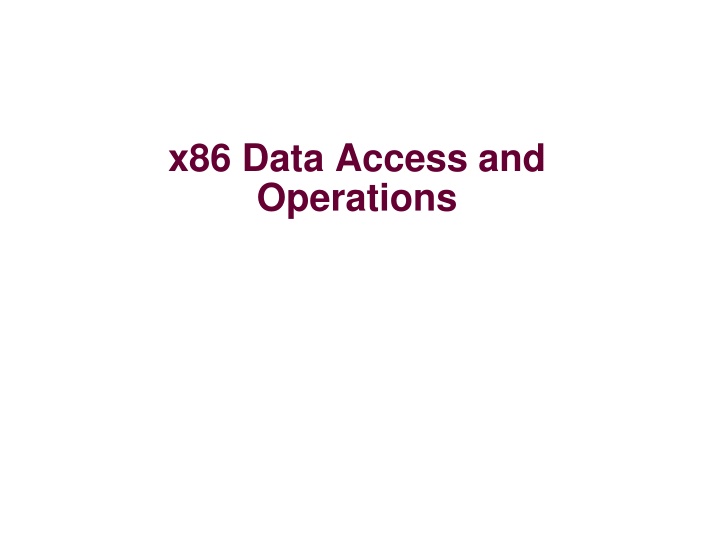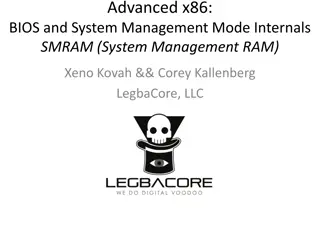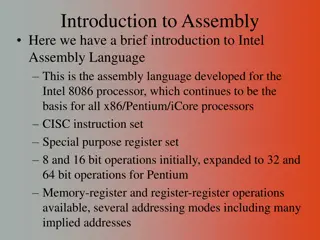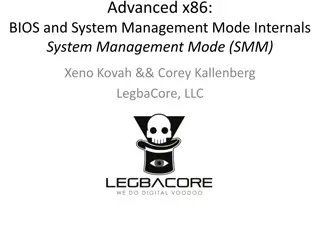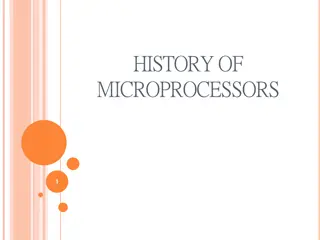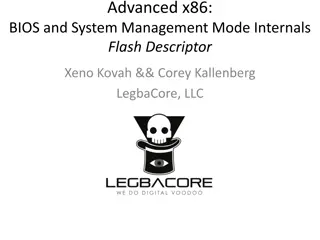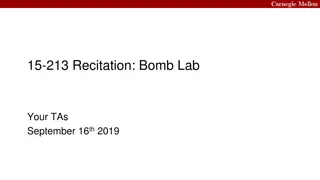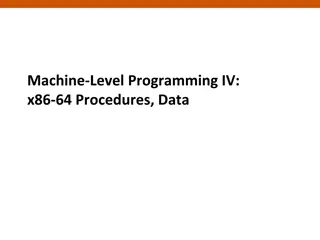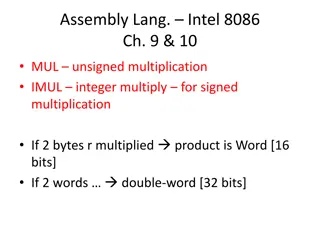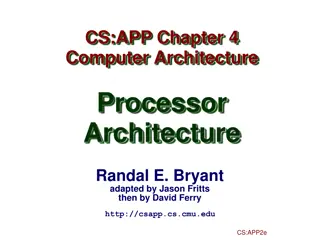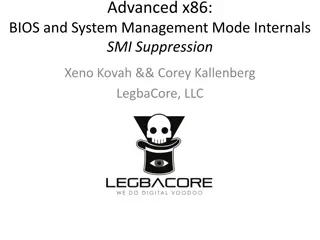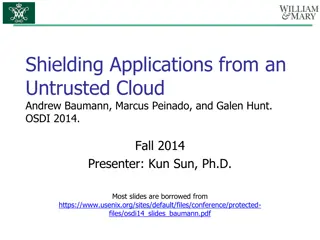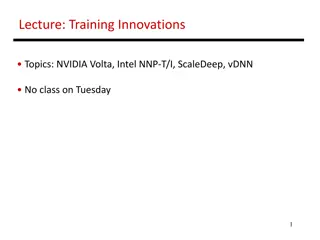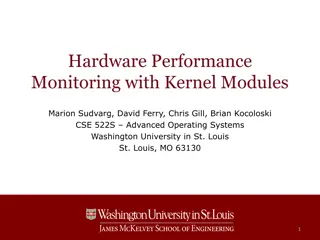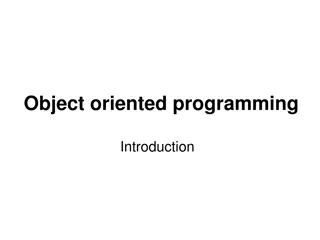Intel x86 Evolution and Programming
Evolution of Intel x86 architecture from 1978 to present, focusing on features, advancements, and programming methods. Learn about machine-level representations, assemblers, programming challenges, and the role of C language in programming x86 systems.
Download Presentation

Please find below an Image/Link to download the presentation.
The content on the website is provided AS IS for your information and personal use only. It may not be sold, licensed, or shared on other websites without obtaining consent from the author.If you encounter any issues during the download, it is possible that the publisher has removed the file from their server.
You are allowed to download the files provided on this website for personal or commercial use, subject to the condition that they are used lawfully. All files are the property of their respective owners.
The content on the website is provided AS IS for your information and personal use only. It may not be sold, licensed, or shared on other websites without obtaining consent from the author.
E N D
Presentation Transcript
x86 Data Access and Operations
Machine-Level Representations Prior lectures Data representation This lecture Program representation Encoding is architecture dependent We will focus on the Intel x86-64 or x64 architecture Prior edition used IA32 2
Intel x86 Evolutionary design starting in 1978 with 8086 i386 in 1986: First 32-bit Intel CPU (IA32) Virtual memory fully supported Pentium4E in 2004: First 64-bit Intel CPU (x86-64) Adopted from AMD Opteron (2003) Core 2 in 2006: First multi-core Intel CPU New features and instructions added over time Vector operations for multimedia Memory protection for security Conditional data movement instructions for performance Expanded address space for scaling But, many obsolete features Complex Instruction Set Computer (CISC) Many different instructions with many different formats But we ll only look at a small subset 3
2015 Core i7 Broadwell 4
How do you program it? Initially, no compilers or assemblers Machine code generated by hand! Error-prone Time-consuming Hard to read and write Hard to debug 5
Assemblers Assign mnemonics to machine code Assembly language for specifying machine instructions Names for the machine instructions and registers movq %rax, %rcx There is no standard for x86 assemblers Intel assembly language AT&T Unix assembler Microsoft assembler GNU uses Unix style with its assembler gas Even with the advent of compilers, assembly still used Early compilers made big, slow code Operating Systems were written mostly in assembly, into the 1980s Accessing new hardware features before compiler has a chance to incorporate them 6
Then, via C void sumstore(long x, long y, long *D) { long t = plus(x, y); *D = t; } sumstore: pushq %rbx movq %rdx, %rbx call plus movq %rax, (%rbx) popq %rbx ret 7
Assembly Programmers View CPU Memory Addresses Registers Object Code Program Data OS Data Data RIP (PC) Condition Codes Instructions Stack Visible State to Assembly Program RIP Instruction Pointer or Program Counter Address of next instruction Register File Heavily used program data Condition Codes Store status information about most recent arithmetic or logical operation Used for conditional branching Memory Byte addressable array Code, user data, OS data Includes stack used to support procedures 8
64-bit memory map 48-bit canonical addresses to make page-tables smaller Kernel addresses have high-bit set 0x7ffe96110000 user stack (created at runtime) %esp (stack pointer) 0xffffffffffffffff memory mapped region for shared libraries reserved for kernel (code, data, heap, stack) 0x7f81bb0b5000 0xffff800000000000 brk run-time heap (managed by malloc) memory invisible to user code read/write segment (.data, .bss) read-only segment (.init, .text, .rodata) loaded from the executable file 0x00400000 unused 0 cat /proc/self/maps 9
Registers Special memory not part of main memory Located on CPU Used to store temporary values Typically, data is loaded into registers, manipulated or used, and then written back to memory 10
x86-64 Integer Registers %rax %r8 %eax %r8d %rbx %r9 %ebx %r9d %rcx %r10 %ecx %r10d %rdx %r11 %edx %r11d %rsi %r12 %esi %r12d %rdi %r13 %edi %r13d %rsp %r14 %esp %r14d %rbp %r15 %ebp %r15d 11 Format different since registers added with x86-64
64-bit registers Multiple access sizes %rax, %rbx, %rcx, %rdx %ah, %al : low order bytes (8 bits) %ax : low word (16 bits) %eax : low double word (32 bits) %rax : quad word (64 bits) 31 15 7 0 63 %ax %rax %eax %ah %al Similar access for %rdi, %rsi, %rbp, %rsp 12
64-bit registers Multiple access sizes %r8, %r9, , %r15 %r8b : low order byte (8 bits) %r8w : low word (16 bits) %r8d : low double word (32 bits) %r8 : quad word (64 bits) 31 15 7 0 63 %r8w %r8 %r8d %r8b 13
Register evolution The x86 architecture initially register poor Few general purpose registers (8 in IA32) Initially, driven by the fact that transistors were expensive Then, driven by the need for backwards compatibility for certain instructions pusha (push all) and popa (pop all) from 80186 Other reasons Makes context-switching amongst processes easy (less register-state to store) Fast caches easier to add to than more registers (L1, L2, L3 etc.) 14
Instructions A typical instruction acts on 2 or more operands of a particular width addq %rcx, %rdx adds the contents of rcx to rdx addq stands for add quad word Size of the operand denoted in instruction Why quad word for 64-bit registers? Baggage from 16-bit processors Now we have these crazy terms 8 bits = byte = addb 16 bits = word = addw 32 bits = double or long word = addl 64 bits = quad word = addq 15
C types and x86-64 instructions C Data Type Intel x86-64 type GAS suffix x86-64 char byte b 1 short word w 2 int double word l 4 long quad word q 8 float single precision s 4 double double precision d 8 extended precision long double t 10/16 pointer quad word q 8 16
Instruction operands %rax %rcx %rdx %rbx %rsi %rdi %rsp %rbp Example instruction movqSource, Dest Three operand types Immediate Constant integer data (C constant) Preceded by $ (e.g., $0x400, $-533) Encoded directly into instructions Register: One of 16 integer registers Example: %rax, %r13 Note %rsp reserved for special use Memory: a memory address Multiple modes Simplest example: (%rax) %rN 17
Immediate mode Immediate has only one mode Form: $Imm Operand value: Imm movq $0x8000,%rax movq $array,%rax int array[30]; /* array = global var. stored at 0x8000 */ 0x8000 Main memory %rax %rcx 0x8000 array %rdx 18
Register mode Register has only one mode Form: Ea Operand value: R[Ea] movq %rcx,%rax Main memory %rax %rcx 0x0030 0x8000 %rdx 19
Memory modes Memory has multiple modes Absolute specify the address of the data Indirect use register to calculate address Base + displacement use register plus absolute address to calculate address Indexed Indexed Add contents of an index register Scaled index Add contents of an index register scaled by a constant 20
Memory modes Memory mode: Absolute Form: Imm Operand value: M[Imm] movq 0x8000,%rax movq array,%rax long array[30]; /* global variable at 0x8000 */ Main memory %rax %rcx 0x8000 array %rdx 21
Memory modes Memory mode: Indirect Form: (Ea) Operand value: M[R[Ea]] Register Ea specifies the memory address movq (%rcx),%rax Main memory %rax %rcx 0x8000 0x8000 %rdx 22
Memory modes Memory mode: Base + Displacement Form: Imm(Eb) Used to access structure members Operand value: M[Imm+R[Eb]] Register Eb specifies start of memory region Imm specifies the offset/displacement movq 16(%rcx),%rax Main memory 0x8018 %rax 0x8010 0x8008 %rcx 0x8000 0x8000 %rdx 23
Memory modes Memory mode: Scaled indexed Most general format Used for accessing structures and arrays in memory Form: Imm(Eb,Ei,S) Operand value: M[Imm+R[Eb]+S*R[Ei]] Register Eb specifies start of memory region Ei holds index S is integer scale (1,2,4,8) movq 8(%rdx,%rcx,8),%rax Main memory 0x8028 0x8020 0x8018 %rax 0x8010 0x8008 %rcx 0x03 0x8000 %rdx 0x8000 24
Operand examples using movq Source Destination C Analog Reg Mem movq $0x4,%rax temp = 0x4; Imm *p = -147; movq $-147,(%rax) Reg Mem movq %rax,%rdx temp2 = temp1; Reg movq *p = temp; movq %rax,(%rdx) Mem Reg movq (%rax),%rdx temp = *p; Memory-memory transfers cannot be done with single instruction 25
Addressing Mode walkthrough Add the double word at address rbp + 12 to ecx addl 12(%rbp),%ecx Load the byte at address rax + rcx into dl movb (%rax,%rcx),%dl Subtract rdx from the quad word at address rcx+(8*rax) subq %rdx,(%rcx,%rax,8) Increment the word at address 0xA+(8*rcx) incw 0xA(,%rcx,8) Also note: We do not put $ in front of constants unless they are used to indicate immediate mode. The following are incorrect addl $12(%rbp),%ecx subq %rdx,(%rcx,%rax,$8) incw $0xA(,%rcx,$8) 26
Carnegie Mellon Address computation walkthrough %rdx 0xf000 %rcx 0x0100 Expression Address Computation Address 0xf000 + 0x8 0xf008 0x8(%rdx) 0xf000 + 0x100 0xf100 (%rdx,%rcx) (%rdx,%rcx,4) 0xf000 + 4*0x100 0xf400 2*0xf000 + 0x80 0x1e080 0x80(,%rdx,2) 27
Practice Problem 3.1 Register Value Operand Value %rax %rax 0x100 0x100 0xAB 0x108 0xFF 0xAB 0x13 0xAB 0xFF 0x11 %rcx 0x1 0x108 %rdx 0x3 $0x108 (%rax) Address Value 8(%rax) 0x100 0xFF 13(%rax, %rdx) 0x108 0xAB 260(%rcx, %rdx) 0x110 0x13 0xF8(, %rcx, 8) 0x118 0x11 (%rax, %rdx, 8) 28
Example: swap() Memory Registers void swap(long *xp, long *yp) { long t0 = *xp; long t1 = *yp; *xp = t1; *yp = t0; } %rdi %rsi %rax %rdx Register %rdi %rsi %rax %rdx Value xp yp t0 t1 swap: movq (%rdi), %rax # t0 = *xp movq (%rsi), %rdx # t1 = *yp movq %rdx, (%rdi) # *xp = t1 movq %rax, (%rsi) # *yp = t0 ret 29
Understanding swap() Memory Registers Address 0x120 123 %rdi 0x120 0x118 %rsi 0x100 0x110 %rax 0x108 %rdx 456 0x100 swap: movq (%rdi), %rax # t0 = *xp movq (%rsi), %rdx # t1 = *yp movq %rdx, (%rdi) # *xp = t1 movq %rax, (%rsi) # *yp = t0 ret 30
Understanding swap() Memory Registers Address 0x120 123 %rdi 0x120 0x118 %rsi 0x100 0x110 %rax 123 0x108 %rdx 456 0x100 swap: movq (%rdi), %rax # t0 = *xp movq (%rsi), %rdx # t1 = *yp movq %rdx, (%rdi) # *xp = t1 movq %rax, (%rsi) # *yp = t0 ret 31
Understanding swap() Memory Registers Address 0x120 123 %rdi 0x120 0x118 %rsi 0x100 0x110 %rax 123 0x108 %rdx 456 456 0x100 swap: movq (%rdi), %rax # t0 = *xp movq (%rsi), %rdx # t1 = *yp movq %rdx, (%rdi) # *xp = t1 movq %rax, (%rsi) # *yp = t0 ret 32
Understanding swap() Memory Registers Address 0x120 456 %rdi 0x120 0x118 %rsi 0x100 0x110 %rax 123 0x108 %rdx 456 456 0x100 swap: movq (%rdi), %rax # t0 = *xp movq (%rsi), %rdx # t1 = *yp movq %rdx, (%rdi) # *xp = t1 movq %rax, (%rsi) # *yp = t0 ret 33
Understanding swap() Memory Registers Address 0x120 456 %rdi 0x120 0x118 %rsi 0x100 0x110 %rax 123 0x108 %rdx 456 123 0x100 swap: movq (%rdi), %rax # t0 = *xp movq (%rsi), %rdx # t1 = *yp movq %rdx, (%rdi) # *xp = t1 movq %rax, (%rsi) # *yp = t0 ret 34
Practice Problem 3.5 A function has this prototype: long decode(long *xp, long *yp, long *zp); Here is the body of the code in assembly language: /* xp in %rdi, yp in %rsi, zp in %rdx */ 1 movq (%rdi), %r8 2 movq (%rsi), %rcx 3 movq (%rdx), %rax 4 movq %r8,(%rsi) 5 movq %rcx,(%rdx) 6 movq %rax,(%rdi) long decode(long *xp, long *yp, long *zp) { long x = *xp; /* Line 1 */ long y = *yp; /* Line 2 */ long z = *zp; /* Line 3 */ *yp = x; /* Line 6 */ *zp = y; /* Line 8 */ *xp = z; /* Line 7 */ return z; } Write C code for this function 35
Practice walkthrough Suppose an array in C is declared as a global variable: long array[34]; Write some assembly code that: sets rsi to the address of array sets rbx to the constant 9 loads array[9] into register rax. Use scaled index memory mode movq $array,%rsi movq $0x9,%rbx movq (%rsi,%rbx,8),%rax 36
Arithmetic and Logical Operations
Load address Load Effective Address (Quad) leaqS, D D &S Loads the address of S in D, not the contents leaq (%rax),%rdx Equivalent to movq %rax,%rdx Destination must be a register Used to compute addresses without a memory reference e.g., translation of p = &x[i]; 38
Load address leaqS, D Commonly used by compiler to do simple arithmetic If %rdx = x, leaq 7(%rdx, %rdx, 4), %rdx Multiply and add all in one instruction Example D &S 5x + 7 long m12(long x) { return x*12; } Converted to ASM by compiler: leaq (%rdi,%rdi,2), %rax # t <- x+x*2 salq $2, %rax # return t<<2 39
Practice Problem 3.6 walkthrough %rax = x, %rcx = y Expression Result in %rdx leaq 6(%rax), %rdx x+6 leaq (%rax, %rcx), %rdx x+y leaq (%rax, %rcx, 4), %rdx x+4y leaq 7(%rax, %rax, 8), %rdx 9x+7 leaq 0xA(, %rcx, 4), %rdx 4y+10 leaq 9(%rax, %rcx, 2), %rdx x+2y+9 40
Carnegie Mellon Two Operand Arithmetic Operations Accumulated operation Second operand is both a source and destination A bit like C operators += , -= , etc. Max shift is 64 bits, so k is either an immediate byte, or register (e.g. %cl where %cl is byte 0 of register %rcx) Format Computation Computation addq S, D D = D + S subq S, D D = D S imulq S, D D = D * S salq S, D D = D << S sarq S, D D = D >> S shrq S, D D = D >> S xorq S, D D = D ^ S andq S, D D = D & S orq S, D D = D | S Format Also called Also called shlq Arithmetic shift right (sign extend) Arithmetic shift right (sign extend) Logical shift right (zero fill) Logical shift right (zero fill) shlq 41
Carnegie Mellon One Operand Arithmetic Operations Format Format incq decq negq notq D D D D Computation Computation D = D + 1 D = D 1 D = D D = ~D See book for more instructions 42
Practice Problem 3.8 Address Value Register Value %rax 0x100 0x100 0xFF %rcx 0x1 0x108 0xAB %rdx 0x3 0x110 0x13 0x118 0x11 Instruction Destination address Result addq %rcx, (%rax) 0x100 0x100 0x108 0xA8 0x118 0x110 0x110 0x14 subq %rdx, 8(%rax) imulq $16, (%rax, %rdx, 8) incq 16(%rax) decq %rcx %rcx 0x0 subq %rdx, %rax %rax 0xFD 43
Practice Problem 3.9 long shift_left4_rightn(long x, long n) { x <<= 4; x >>= n; return x; } _shift_left4_rightn: movq movq ret %rdi, %rax %rsi, %rcx %cl, %rax ; get x ; x <<= 4; ; get n ; x >>= n; salq $4, %rax sarq 44
Carnegie Mellon Arithmetic Expression Example arith: leaq (%rdi,%rsi), %rax # t1 addq %rdx, %rax # t2 leaq (%rsi,%rsi,2), %rdx salq $4, %rdx # t4 leaq 4(%rdi,%rdx), %rcx # t5 imulq %rcx, %rax # rval ret Compiler trick to generate efficient code long arith (long x, long y, long z) { long t1 = x+y; long t2 = z+t1; long t3 = x+4; long t4 = y * 48; long t5 = t3 + t4; long rval = t2 * t5; return rval; } Register Use(s) %rdi Argument x %rsi Argument y %rdx Argument z %rax t1, t2, rval %rdx t4 %rcx t5 45
Practice Problem 3.10 What does this instruction do? xorq %rdx, %rdx Zeros out register How might it be different than this instruction? movq $0, %rdx 3-byte instruction versus 7-byte Null bytes encoded in instruction 46
Extra slides 47
Exam practice Chapter 3 Problems (Part 1) 3.1 3.2,3.3 3.4 3.5 3.6 3.7 3.8 3.9 3.10 3.11 x86 operands instruction operand sizes instruction construction disassemble to C leaq leaq disassembly operations in x86 fill in x86 from C fill in C from x86 xorq 48
Definitions Architecture or instruction set architecture (ISA) Instruction specification, registers Examples: x86 IA32, x86-64, ARM Microarchitecture Implementation of the architecture Examples: cache sizes and core frequency Machine code (or object code) Byte-level programs that a processor executes Assembly code A text representation of machine code 49
Disassembling Object Code Disassembled 0000000000400595 <sumstore>: 400595: 53 push %rbx 400596: 48 89 d3 mov %rdx,%rbx 400599: e8 f2 ff ff ff callq 400590 <plus> 40059e: 48 89 03 mov %rax,(%rbx) 4005a1: 5b pop %rbx 4005a2: c3 retq Disassembler objdump d sumstore Useful tool for examining object code Analyzes bit pattern of series of instructions Produces approximate rendition of assembly code Can be run on either a.out (complete executable) or .o file 50
